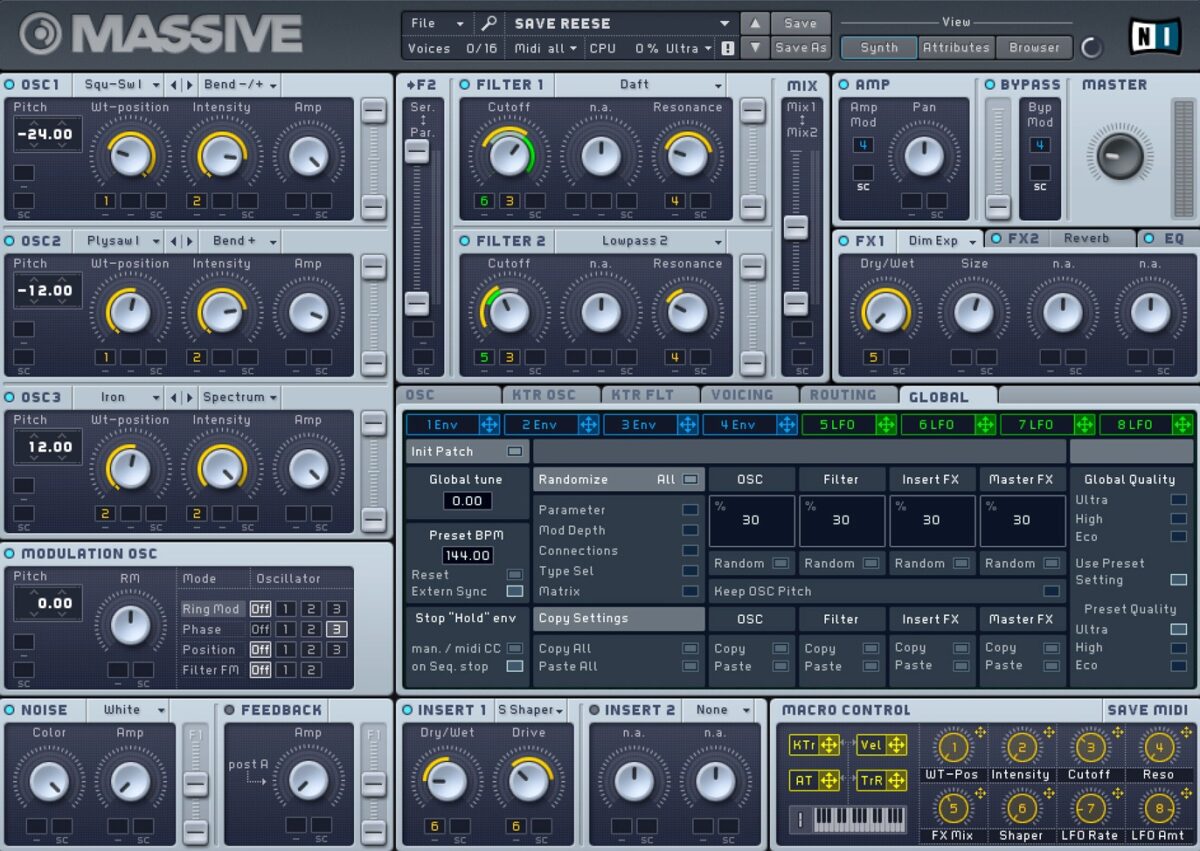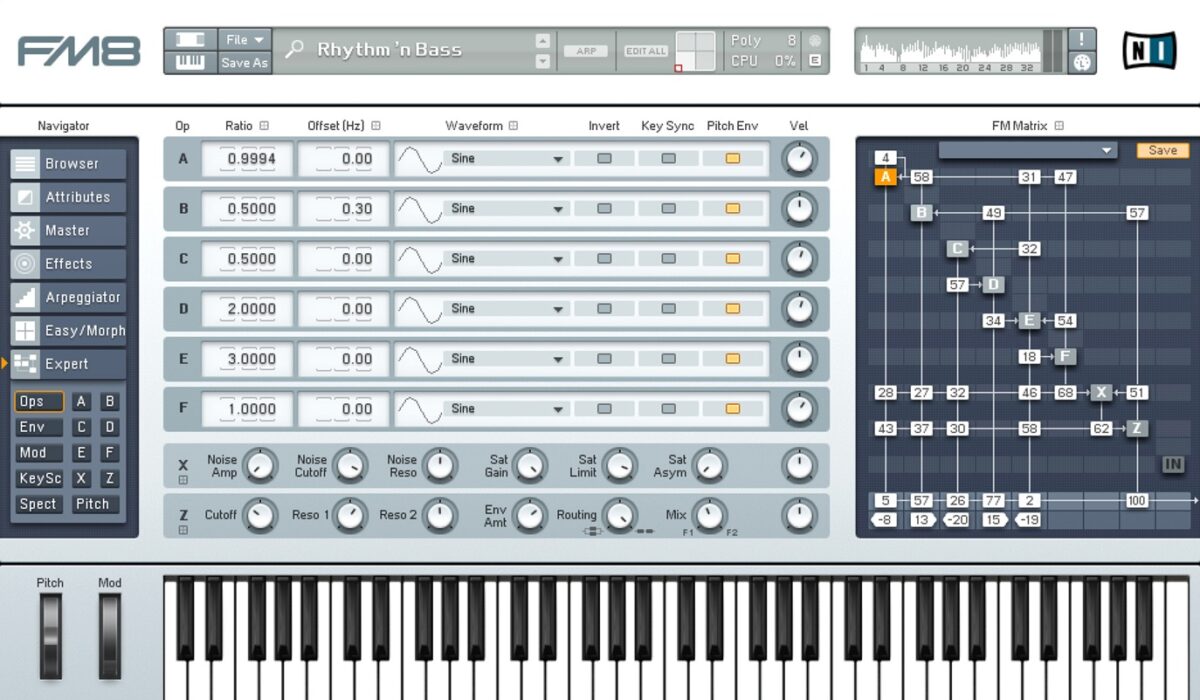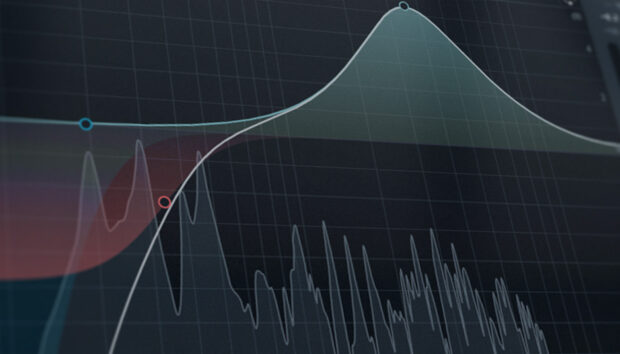
Bass synthesizers are electronic instruments designed specifically to generate and manipulate low-frequency sounds, commonly used to produce basslines in music. They utilize oscillators, filters, and modulation to craft a wide range of deep, resonant, and often dynamic bass tones.
Bass synthesizers can turn a good track into a great one with just a few low-frequency waves. We’ll touch on what these bad boys do in the mix and how they differ from regular synths. And, once we’ve covered the basics, discover five solid ways to use bass synths in your music. These tips will help you leverage some low-end power to add depth and impact that’ll resonate with your listeners (literally).
So, get comfy and crank up your sub, because today is all about that bass.
Jump to these sections:
- What does a bass synthesizer do?
- What’s the difference between a synth and a bass synth?
- 5 ways to use bass synths
Follow along with Komplete, a powerhouse of music production tools including synths, sampled instruments, orchestral libraries, effects, and more.
What is a bass synth?
Bass synths are there to pump out the low hum and buzz to fill out a track, giving it weight and warmth. Synth bass works beneath the layers of melody and rhythm to make sure your tune carries the type of bass that can be felt in the chest as much as it’s heard in the ears. Bass synths aren’t just there to make noise, they’re used to help set the vibe and make sure your music has the substance it needs to sound full and rich.
What’s the difference between a synth and a bass synth?
So, what is the difference between a synth and a bass synth, exactly? Think of a synthesizer as a chameleon – it’s versatile, changing colors with the flick of a knob or the press of a key, covering a wide range of frequencies. A bass synth, on the other hand, is like a dedicated Olympic weightlifter, specializing in the heavy lifting of the low-end spectrum. Bass synthesizers are designed to pump out deep, thick bass lines that give your tracks that coveted impact.
In essence, all bass synths are synths, but not all synths can flex their muscles in the bass department as effectively. It’s the difference between having a “jack-of-all-trades” and a “master of one.” And when you’re looking to add depth and impact to your music, knowing how to use bass synths is really gonna take you far.
Understanding how to use bass synths in your compositions is incredibly important – especially if you’re producing electronic music. So, let’s dive into some different ways to bring some love to the low-end.
5 ways to use bass synths
Unleashing the power of bass synths in your music opens a world of sonic possibilities. From anchoring the rhythmic groove to crafting atmospheric textures, here are five ways to harness bass synthesizers in your productions.
1. Support the foundation of the song
Let’s start with the bass-ics. When put to work in the right way, bass synths can help add a solid foundation underneath the rest of your instrumentation. For example, if you have your synth bass following along with the root notes of your chord progression it can serve as a sort of bedrock for all your various melodies and harmonies to sit on top of. Take a listen to this track I’ve been working on – first, without any synth bass:
It definitely has a lot going on in the higher frequencies, but without anything in the low end holding it all together, it can be easy to get lost in all the ambient textures. So, to help glue it all together, I’m going to add a bass line using Massive.

Massive is great for creating all sorts of synth bass sounds, from dubstep whomps to electro house donks. But, for this demo, I’ll be using a preset from the Stadium Flex Expansion called “Save Reese.” This particular preset has some subtle movement to it that I really like. Plus, its ability to play long, drawn out notes will serve this track well. Give it a listen.
By simply having the synth bass follow my chord progression, it provides a good, solid foundation for all of the higher frequencies to play on top of. Here’s the updated track with the synth bass line added:
Notice how the synth bass provides a bit more structure to the track? It helps guide the listener along during chord transitions, and provides a consistent, rich floor of low frequencies for everything else to dance on.
2. Generate powerful sub bass tones
Sometimes, you just need to feel the music. Synth bass can generate those powerful sub bass tones that you don’t just hear – you feel. I’m talking about that low-end that rattles your ribcage. These sub tones are the secret sauce behind that physical oomph in clubs and on dance floors.
I’ve found that the best bass synth for creating deep sub tones is TRK-01 because it gives you full control over just how “subby” you want it.

Take this track for example:
It’s got the potential to be bumpin’, but it’s just not quite there yet. Let’s throw in a sub bass synth that follows the beat and I’m sure that it’ll hit the spot. To do this, I’ll simply load up one of the built-in presets in TRK-01 called “Slam Fold” and record a bass line following the existing rhythm. Check it out.
It really hits you in the gut! Now, give it a listen in context with the rest of the mix.
See how much adding some sub bass synth power helped out the track? I will warn you, though, to be careful with this technique since playing with sub bass requires a bit of specialized care. Check out this guide on how bass works to make sure your low end bumps just the way you want.
3. Create melodic bass lines
Who says bass lines just have to “bum-bum-bum”? One of the most fun ways for how to use synth bass is to craft melodic bass lines that do more than just underline the track – they steal the show. Think of those iconic bass lines that stick with you. The ones that you hum while you’re making your morning coffee. That’s the power of a melodic bass line.
To show you what I mean, I’ll share a bass line I wrote for one of my tracks using the Monark bass synth.

Monark is great for making mono basses with an organic analog sound and feel. For this specific track, I chose to go with a preset called “Radioaktive.” Check it out:
Pretty catchy, am I right? Here’s that synth bass line in context with the rest of the track:
If you want to learn more about crafting melodic bass lines like that, check out these articles on how to write a bass line and how to create MIDI bass lines that groove.
4. Use textured bass to create atmosphere
Bass synths aren’t always just about the notes you play – they’re also about the sonic depth they can add. By using different waveforms, filters, and modulation on your bass synths, you can bring in an extra layer of texture and atmosphere to any track.
When I’m looking for really textured bass synth sounds, I love using FM8.

FM8 excels in adding richly textured bass and atmospheric depth to tracks due to its frequency modulation synthesis capabilities. It’s capable of creating bass synth sounds that can morph, evolve, and contribute to the emotional landscape of your music.
Here, check this out: I’ll first play one note using a Massive preset called “Tapout” from the Elastic Thump Expansion.
Now, I’ll throw in a simple bass line using one of the presets in FM8 called “Rhythm ’n Bass.” Here’s the bass line by itself:
Now, give them a listen together.
See what I mean? Just with two simple tracks, there’s already so much depth and atmosphere! With FM8, you’re not just laying down a groove – you’re painting with sound, crafting bass that breathes life and complexity into your compositions.
5. Creative FX and experimentation
Last but not least, let’s not forget the wild side of bass synths. If you wanna get experimental with the low-end, go ahead and let your freak flag fly. Twisting knobs, bending pitches, and layering effects can turn a simple bass sound into a sonic experiment that pushes your music into new territories.
If I’m looking to really get weird, I’ll load up Massive X and just start fiddling around.

When it comes to creating unique synth bass sounds no one has ever heard before, Massive X is in a league of its own. It already comes loaded with tons of really experimental, evolving sounds. But, you can also bulk up its library with several Massive X Expansions. For example, check out this creative synth bass made with a Massive X preset called “Carnivore” from the Pulse Expansion.
Or, how about this one made with the “Arch Bucket” preset from the Mechanix Expansion:
One last one, made with a preset called “Sluggish” (also from the Mechanix Expansion):
When it comes to using bass synths to add creative fx and experimental sounds, it’s all about breaking rules, making noise, and sometimes, just seeing what happens.
Start using bass synths in your music
And there you have it. Whether you’re reinforcing the foundation, shaking the floor with sub bass, crafting catchy melodies, setting the mood with atmospheric textures, or boldly going where no producer has gone before, bass synths are your ticket to a sound that’s as deep as the ocean and as wide as your imagination.
If you want access to all of the incredible bass synthesizers I’ve used in this article, go get a copy of Komplete (it includes all of them, plus dozens of extra tools to level up your production game)!















